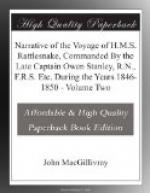On a former occasion I had made an excursion to the summit of La Pouce, a remarkable knob-like peak on the sharp crateriform ridge behind Port Louis. Following a path, leading from the town directly to Wilhelm’s Plains, one crosses a small stream and skirts the steep face of the hill over rough ground covered with burnt up grass, and straggling bushes. To this succeeds a region of evergreens (among which the wild mango is the prevailing tree) where a species of monkey introduced many years ago into the island has taken up its abode. I saw none, however, but occasionally heard their chattering as they hurried along among the bushes. Where the path crosses the ridge, it widens out into a succession of rounded eminences, with the summit of La Pouce rising suddenly from its centre in a thumb-like form. Its base is watered by a small gushing rill, and the vegetation now is very luxuriant from the continual supply of moisture. The most striking plants are the tree-ferns (Cyathea excelsa and C. bourbonica) some of which attain a height of from fifteen to twenty feet. From the eastern margin of the ridge the view is very fine; a sloping precipice, several hundred feet in height, covered with stunted bushes, overlooks Wilhelm’s Plains, nearly all under cultivation and studded with sugar plantations. The soil, when newly turned up, appeared of a dull red colour. Numbers of tropic birds were flying along the face of the cliff where they probably breed. Eight species of land shells were picked up here, either creeping up the grass or under stones and logs; they were of the genera Caracolla, Helix, and Pupa.
A narrow path, difficult to find among the long grass, leads to the summit of the mountain, 2600 feet above the level of the sea. The view from the top embraces the greater part of this fine island. The coral reef fringing the shores is well seen—the pale green of the shoal water is separated from the deep blue of the ocean by a line of snow-white surf.
The cemetery.
For entomological purposes I frequently visited the Cemetery, numbers of insects being attracted by its flowers and trees. The road leading to it, one of the principal evening drives, is shaded by rows of magnificent casuarinas, from Madagascar. Some five or six widely-separated religious creeds may each here be seen practising their peculiar modes of interment—Chinese, Mahomedan, Hindoo, and Christian; and among the last it was a novelty to me to observe, for the first time, the pleasing custom of decking the graves with fresh flowers, often renewed weekly for years, disposed in jars of various kinds, from the richly ornamented vase down to the humblest piece of crockery. All the low land hereabouts has been borrowed from the sea; it is a mixture of sand and fragments of coral; and the land-crabs have established a colony in one part of the cemetery, and run riot among the graves.




